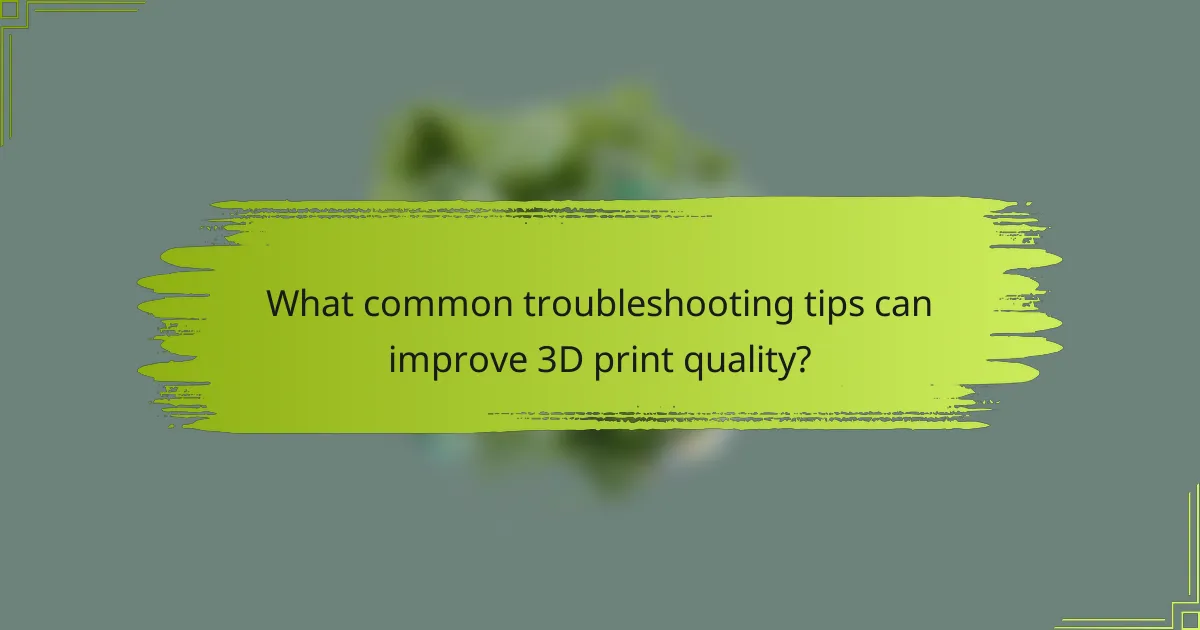
What are the key factors in optimizing print settings for superior 3D print quality?
Key factors in optimizing print settings for superior 3D print quality include layer height, print speed, and temperature. Layer height affects detail and strength; lower heights yield finer details. Print speed influences the accuracy of the print; slower speeds enhance precision. Temperature settings must match the filament type; incorrect temperatures can lead to warping or poor adhesion. Bed leveling is crucial for first-layer adhesion; an unlevel bed can cause print failures. Cooling settings impact the cooling rate of the material; proper cooling prevents stringing and improves surface finish. Material selection also affects print quality; different filaments have unique properties that influence the final result.
How do print speed and layer height influence print quality?
Print speed and layer height significantly influence print quality in 3D printing. Higher print speeds can lead to decreased accuracy and detail. This occurs because the extruder may not deposit filament precisely, resulting in defects. Conversely, slower speeds allow for better layer adhesion and detail, enhancing overall quality. Layer height also plays a crucial role; thinner layers yield smoother surfaces and finer details. Thicker layers can reduce print time but may create visible layer lines. Studies show that optimal settings often balance speed and height to achieve desired results. For instance, a layer height of 0.1 mm at a moderate speed typically results in superior quality.
What is the ideal print speed for different materials?
The ideal print speed varies by material. For PLA, the optimal speed is typically 50-60 mm/s. For ABS, a speed of 40-50 mm/s is recommended. PETG performs best at 30-50 mm/s. TPU, being flexible, requires a slower speed of 20-30 mm/s. High-speed printing can lead to defects like stringing or layer adhesion issues. Each material’s properties affect how it interacts with heat and extrusion. Adjusting speed according to these characteristics ensures better print quality and accuracy.
How does layer height affect detail and strength in prints?
Layer height significantly influences both detail and strength in 3D prints. A smaller layer height enhances detail by allowing finer features to be captured. This is crucial for intricate designs where precision is vital. Conversely, a larger layer height can reduce print time and improve strength. Thicker layers lead to better adhesion between layers, enhancing overall structural integrity. However, very thick layers may compromise the level of detail. Research indicates that an optimal balance is necessary for achieving desired print quality. For example, a layer height of 0.1 mm is often recommended for detailed prints, while 0.2 mm or more is suitable for stronger, less detailed prints.
What role does temperature play in achieving optimal print quality?
Temperature significantly influences optimal print quality in 3D printing. The extrusion temperature affects the viscosity of the filament. Higher temperatures can improve flow and adhesion between layers. However, excessive heat may lead to stringing and warping. Each filament type has a recommended temperature range for best results. For example, PLA typically requires 180-220°C, while ABS needs 220-250°C. Maintaining the correct temperature ensures consistent layer bonding and reduces defects. Studies show that temperature variations can lead to dimensional inaccuracies in prints. Proper temperature settings are essential for achieving high-quality, detailed 3D prints.
How do nozzle and bed temperatures impact adhesion and flow?
Nozzle and bed temperatures significantly impact adhesion and flow in 3D printing. Higher nozzle temperatures can improve material flow, allowing for smoother extrusion. This is crucial for achieving even layers and reducing clogging. Conversely, lower temperatures may lead to under-extrusion and poor layer bonding. Bed temperatures help maintain adhesion between the print and the build surface. A heated bed reduces the risk of warping during cooling. Optimal bed temperatures also facilitate better first layer adhesion, essential for print stability. Research indicates that specific temperature settings enhance the performance of various filament types. For instance, PLA typically adheres better at bed temperatures around 60°C, while ABS requires higher temperatures near 100°C for optimal adhesion.
What are the recommended temperature settings for various filaments?
PLA typically requires a nozzle temperature of 180-220°C. ABS is best printed at 220-250°C. PETG settings range from 220-250°C. Nylon filaments usually need 240-260°C. TPU is effective at 210-230°C. Each filament type has its optimal range for adhesion and flow. These temperatures ensure proper melting and extrusion. Accurate settings minimize warping and improve layer adhesion.
Why is bed leveling crucial for superior 3D print quality?
Bed leveling is crucial for superior 3D print quality because it ensures a consistent distance between the nozzle and the print bed. This consistency allows for optimal adhesion of the first layer. Proper adhesion prevents warping and shifting during printing. Uneven bed surfaces can lead to inconsistent extrusion and layer misalignment. Research indicates that a well-leveled bed can improve first layer adhesion by up to 50%. This improvement directly correlates with overall print success and quality. In summary, bed leveling is essential for achieving precise and high-quality 3D prints.
How can improper bed leveling affect the first layer?
Improper bed leveling can lead to adhesion issues in the first layer of a 3D print. When the bed is not level, the nozzle may be too far or too close to the print surface in different areas. This inconsistency affects how the filament adheres to the bed. If the nozzle is too far, the filament may not stick, causing the print to fail. Conversely, if the nozzle is too close, it can squish the filament, leading to uneven layers. According to a study by R. S. B. et al. in “Journal of Manufacturing Processes,” proper bed leveling significantly enhances first layer quality and overall print success.
What techniques can be used for effective bed leveling?
Effective bed leveling techniques include manual leveling, automatic bed leveling, and using a leveling probe. Manual leveling involves adjusting the bed height at each corner using a piece of paper to gauge the distance from the nozzle. Automatic bed leveling uses sensors to measure the distance between the nozzle and bed at multiple points. A leveling probe can provide precise measurements and adjustments for consistent results. These techniques ensure the nozzle maintains the correct distance from the bed during printing, which is crucial for adhesion and print quality. Proper bed leveling significantly reduces issues like warping and poor first layer adhesion.

How can different slicer settings enhance print quality?
Different slicer settings can significantly enhance print quality. Adjusting layer height impacts detail; finer layers produce smoother surfaces. Print speed influences accuracy; slower speeds allow for better layer adhesion. Infill density affects strength; higher densities create sturdier prints. Temperature settings can prevent warping; optimal temperatures ensure proper filament flow. Retraction settings reduce stringing; proper retraction minimizes unwanted filament trails. Support structures can enhance complex designs; well-placed supports prevent sagging. Each of these settings plays a crucial role in achieving high-quality prints.
What are the essential slicer settings to consider for quality optimization?
Essential slicer settings for quality optimization include layer height, print speed, and temperature. Layer height affects the detail and smoothness of the print. A smaller layer height yields finer details but increases print time. Print speed influences the extrusion quality. Slower speeds often result in better adhesion and detail. Temperature settings must match the filament type for optimal flow and adhesion.
Bed adhesion settings, such as initial layer height and first layer speed, are crucial for preventing warping. Shell thickness and infill percentage also impact the strength and quality of the print. Adjusting these settings based on material and desired print characteristics ensures superior results.
How do infill patterns and densities affect print strength?
Infill patterns and densities significantly influence the strength of 3D prints. Higher infill densities generally increase the print’s strength by providing more material support. For example, a density of 100% offers maximum strength, while lower densities like 20% may result in weaker prints. Different infill patterns, such as grid or honeycomb, distribute forces differently. The honeycomb pattern, for instance, provides a good balance of strength and material efficiency. Research indicates that prints with varied infill patterns can exhibit strength differences of up to 50%. Thus, selecting the appropriate infill density and pattern is crucial for optimizing print strength.
What is the significance of support structures in complex prints?
Support structures are essential in complex prints to ensure stability during the 3D printing process. They prevent sagging and warping of overhangs and intricate designs. Without support structures, layers may collapse, leading to failed prints. Support structures also enhance the overall quality of the final product. They allow for more intricate designs that would otherwise be impossible to achieve. Research shows that using appropriate support settings can reduce print failures by up to 30%. This highlights their critical role in achieving superior print quality.
How can you adjust retraction settings to minimize stringing?
To minimize stringing, adjust the retraction distance and speed in your 3D printer settings. Increasing the retraction distance helps pull the filament back further into the nozzle. A typical retraction distance ranges from 1 to 6 mm, depending on the printer and filament type. Additionally, increasing the retraction speed can reduce the time the filament is exposed to heat, which helps prevent oozing. Recommended retraction speeds are usually between 25 to 100 mm/s.
Reducing the nozzle temperature can also help minimize stringing, as lower temperatures decrease filament flow. For example, lowering the temperature by 5-10°C can significantly reduce stringing without affecting layer adhesion. Testing various combinations of these settings is essential to achieve optimal results for your specific printer and filament.
What are the best practices for configuring retraction distance and speed?
The best practices for configuring retraction distance and speed involve setting the retraction distance between 0.5 mm and 2 mm for most filaments. A shorter retraction distance minimizes stringing while ensuring proper filament flow. For speed, a range of 20 mm/s to 45 mm/s is recommended. Slower speeds reduce the risk of clogs and improve overall print quality. Testing different settings on small prints can help determine the optimal configuration for specific materials. These adjustments are crucial for achieving clean prints with minimal defects.
How does the choice of filament affect retraction needs?
The choice of filament significantly affects retraction needs in 3D printing. Different filaments have varying viscosities and thermal properties. For example, PLA has a lower viscosity compared to PETG. This means PLA typically requires less retraction distance and speed. Conversely, PETG often needs more retraction to prevent stringing due to its higher viscosity.
Additionally, flexible filaments like TPU require careful retraction settings to avoid clogs. This is because they can compress during retraction, leading to inconsistent extrusion. The printing temperature also influences retraction; higher temperatures can increase filament flow, necessitating adjustments in retraction settings.
In summary, the specific characteristics of the filament dictate how much retraction is needed to achieve clean prints. Properly adjusting these settings is crucial for optimizing print quality.

What common troubleshooting tips can improve 3D print quality?
Calibrating the 3D printer can significantly improve print quality. Regularly check and adjust the bed leveling to ensure proper adhesion. Using the correct nozzle temperature for the filament type enhances extrusion consistency. Adjusting print speed can reduce issues like stringing or under-extrusion. Ensuring proper filament storage prevents moisture absorption, which can lead to print defects. Cleaning the nozzle regularly helps maintain consistent material flow. Lastly, using a cooling fan can improve layer adhesion and reduce warping. These tips are widely recognized by 3D printing communities and supported by user experiences.
What are the signs of poor print quality and their causes?
Signs of poor print quality include layer misalignment, stringing, and poor adhesion. Layer misalignment occurs when the layers do not line up correctly. This can happen due to mechanical issues or incorrect stepper motor calibration. Stringing is characterized by thin strands of plastic between parts of the print. It often results from improper retraction settings or high printing temperatures. Poor adhesion happens when the print does not stick to the build plate. This can be caused by an unlevel bed or insufficient surface preparation. Other signs include under-extrusion, which leads to gaps in the print, often due to clogged nozzles or low filament feed rates. Each of these signs indicates specific underlying problems that can be addressed to improve print quality.
How can you identify and fix layer separation issues?
To identify layer separation issues, examine the print for visible gaps or misaligned layers. Inspect the model for weak layer adhesion caused by inadequate temperature or speed settings. Adjust the print temperature to ensure proper melting of the filament. Increase the print speed if the layers are not bonding well. Check the material’s specifications for optimal printing conditions.
To fix layer separation, increase the extrusion multiplier to enhance material flow. Ensure the nozzle is clean to prevent clogs. Reduce cooling fan speed during the initial layers to improve adhesion. Additionally, consider adjusting layer height to allow better bonding between layers. Regularly calibrate the 3D printer to maintain optimal performance.
What steps can you take to resolve under-extrusion problems?
To resolve under-extrusion problems, first check the filament feed. Ensure the filament is not tangled or blocked. Next, clean the nozzle to remove any clogs. A clogged nozzle can significantly restrict material flow. Adjust the print temperature if necessary. Insufficient temperature can lead to poor melting of the filament. Increase the flow rate in your slicer settings. This can help deliver more material during printing. Lastly, inspect the extruder gears for wear or slippage. Worn gears can fail to grip the filament properly, causing under-extrusion.
What best practices can be followed for consistent print quality?
To achieve consistent print quality, it is essential to calibrate the printer regularly. Regular calibration ensures that the printer’s components are functioning correctly. This includes checking the nozzle height and bed leveling. Proper bed adhesion is crucial for preventing warping and ensuring prints stick during the process. Selecting the right material for the specific print job also impacts quality. Different materials have unique properties that affect print outcomes. Maintaining a clean print bed and nozzle prevents clogs and defects. It is also important to monitor the print temperature and speed. These settings should align with the material specifications for optimal results. Finally, using high-quality filament contributes to better print consistency. Quality filament minimizes issues like stringing and poor layer adhesion.
How often should maintenance be performed on a 3D printer?
Maintenance on a 3D printer should be performed regularly, ideally every 50 to 100 hours of printing. This frequency helps ensure optimal performance and print quality. Regular maintenance includes checking and cleaning the nozzle, bed leveling, and lubricating moving parts. These tasks prevent clogs and mechanical issues that could affect print quality. Additionally, inspecting belts and pulleys for wear can extend the printer’s lifespan. Following these guidelines will help maintain consistent print quality and reliability.
What are the benefits of using high-quality materials for printing?
High-quality materials for printing enhance the final product’s durability and appearance. They provide better color accuracy and vibrancy. High-quality materials also reduce the likelihood of defects during printing. This leads to fewer print failures and less waste. Additionally, they can improve the overall strength of the printed object. Research shows that using premium materials can increase the lifespan of 3D printed items. For instance, a study by the University of Cambridge found that high-quality filaments can withstand greater stress and strain. Overall, the benefits of high-quality materials significantly contribute to superior print quality and performance.
The main entity of the article is the optimization of print settings for superior 3D print quality. The article outlines key factors such as layer height, print speed, temperature, bed leveling, and material selection that influence print quality. It details how print speed and layer height affect detail and strength, the importance of proper temperature settings for different filaments, and the necessity of bed leveling for adhesion. Additionally, it discusses slicer settings, retraction adjustments, troubleshooting tips, and best practices for maintaining consistent print quality, all aimed at enhancing the overall 3D printing experience.